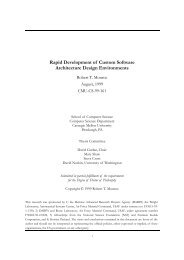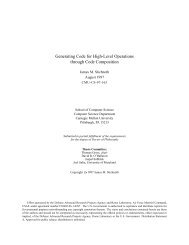Planning under Uncertainty in Dynamic Domains - Carnegie Mellon ...
Planning under Uncertainty in Dynamic Domains - Carnegie Mellon ...
Planning under Uncertainty in Dynamic Domains - Carnegie Mellon ...
You also want an ePaper? Increase the reach of your titles
YUMPU automatically turns print PDFs into web optimized ePapers that Google loves.
2.4. Approaches based on Markov decision processes 13action <strong>in</strong> its plan to achieveany goal or subgoal. This is necessary s<strong>in</strong>ce each <strong>in</strong>dividualaction may fail to achieve the goal with some probability. Buridan can provably nda plan that achieves the threshold probability of success, if a non-branch<strong>in</strong>g planexists that does so. C-Buridan is an extension to Buridan that can create branch<strong>in</strong>gplans, us<strong>in</strong>g a technique similar to that <strong>in</strong>troduced with cnlp [Peot & Smith 1992].Essentially, one new way that C-Buridan can x a candidate plan <strong>in</strong> whichtwo actionsmight <strong>in</strong>terfere with each other is to add a test and restrict the actions to dierentconditional branches based on the test. Information about the branch that an actionbelongs to is then propagated to the action's descendants and ancestors <strong>in</strong> the goaltree.Cassandra [Pryor & Coll<strong>in</strong>s 1993; 1996] is another planner based on snlp anduses an explicit representation of decision steps. Bagchi et al. describe a plannerthat uses a spread<strong>in</strong>g activation technique to choose actions with highest expectedutility [Bagchi, Biswas, & Kawamura 1994]. Onder and Pollack also extend snlpwith explicit reason<strong>in</strong>g about the cont<strong>in</strong>gencies to plan for [Onder & Pollack 1997].Haddawy's thesis work [Haddawy 1991] <strong>in</strong>troduces a logic with extensions to representprobabilities of terms, <strong>in</strong>tended for represent<strong>in</strong>g plans. He and his group havedeveloped hierarchical task-network (htn) planners that use a similar representation[Haddawy & Suwandi 1994; Haddawy, Doan, & Goodw<strong>in</strong> 1995; Haddawy, Doan, &Kahn 1996].While this thesis concentrates ma<strong>in</strong>ly on extensions to classical plann<strong>in</strong>g thatsupport probabilistic plann<strong>in</strong>g <strong>in</strong> uncerta<strong>in</strong> doma<strong>in</strong>s, other work develops extensionsto enable planners to nd high-quality plans accord<strong>in</strong>g to some specied criteria.Perez [Perez & Carbonell 1994; Perez 1995] describes how to learn control knowledgefrom <strong>in</strong>teractions with a human expert that allows Prodigy to produce higher-qualityplans. Williamson and Hanks [Williamson & Hanks 1994; Williamson 1996] developa decision-theoretic extension to ucpop.The planner described <strong>in</strong> this thesis is unique <strong>in</strong> its ability to reason explicitlyabout exogenous events, and to perform a relevance analysis of those events. Vere[Vere 1983] <strong>in</strong>troduced a planner that could reason about exogenous events that wereknown to occur at some xed time, but not about uncerta<strong>in</strong> events.2.4 Approaches based on Markov decision processesIn the past ve years, much of the research activity <strong>in</strong> AI plann<strong>in</strong>g <strong>under</strong> uncerta<strong>in</strong>tyhas built on standard techniques for solv<strong>in</strong>g Markov decision problems (mdps) andpartially-observable Markov decision problems pomdps [Dean et al. 1995; Littman1996; Boutilier, Brafman, & Geib 1997]. This formalism has the advantage of a soundmathematical <strong>under</strong>p<strong>in</strong>n<strong>in</strong>g, and the standard solution techniques aim at an optimalpolicy while most systems based on classical plann<strong>in</strong>g try to meet a lower bound.However these standard techniques are not tractable s<strong>in</strong>ce they require enumerat<strong>in</strong>g







